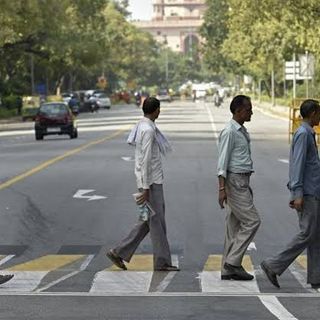
All the Types of Headaches and What Causes Them
With an ailment so ubiquitous, it’s often difficult to pin down how and why a headache occurs — and what will prevent it.

I have a resident headache that accompanies me almost everywhere I go — it starts from one shoulder blade, shoots up either side of my neck, and hangs out at the base of my skull for a bit, before progressing to either temple, where it lets itself be known in rhythmic pulsations. It’s consistent, regular, painful, unwelcome — and very common.
Headaches are a ubiquitous ailment — the first symptom of most diseases as well as most minor health states; if you’re dehydrated, here take a headache; if you’re sleep deprived; a headache is awaiting your pained existence; you have a brain tumor? Headache. How do we even know when a headache needs a glass of water and a burp, or a visit to the doctor?
The tension or stress headache
One of the most common types of headaches is the tension headache, which generally lasts for several hours and manifests as mild to moderate pain across the forehead or back of the head, a tenderness in the neck and shoulders, or a feeling of pressure behind the eyes, according to Harvard Health, Caused by contractions in the neck and shoulder muscles, its triggers can include stress, lack of sleep, fatigue, hunger, or caffeine withdrawal, or abuse of alcohol and cigarettes. They can often be cured by regular sleep, exercise and food habits, better posture, and effective management of stress triggers with therapy. When tension headaches persist for longer than a few hours, and intensify, they can resemble another common type of headache: the migraine.
The migraine(s)
While less frequent than tension headaches, migraines are more intense — they are characterized by throbbing pain in the temple, eye or back of the head, accompanied by nausea or sensitivity to light and sound. Two to three times more common in women than in men, “migraines are caused by changes in the brain’s blood flow and nerve cell activity. Genetics play a role since 70% of migraine victims have at least one close relative with the problem,” according to Harvard Health. Even migraines, however, are usually triggered by changing weather, fluctuating sleep patterns, stress, and sensory triggers such as bright lights or strong smells.
Related on The Swaddle:
Some Doctors See Pain as Just a Sympton of Being Female
20% of migraines are accompanied by neurological symptoms called an “aura,” according to Harvard Health, which can include halos, flashing lights, wavy lines, temporary loss of vision, or numbness and tingling on either side of the body. As for its treatment, “Some people can prevent migraines simply by avoiding triggers. Others do well with prompt therapy for occasional attacks. But patients who suffer frequent migraine attacks often benefit from preventive medications,” Harvard Health delineates.
The cluster headache
According to the International Classification of Headache Disorders, cluster headaches are sudden, recurrent headaches manifesting as piercing, burning pain behind one eye. They’re characterized by a swollen eyelid, runny nose or a watery eye, and usually lasts between 15 minutes and three hours. Cluster headaches occur, well, in clusters, throughout the day, and can persist for weeks or months. Medical professionals advise avoiding alcohol and cigarettes during cluster headaches, and can prescribe medication suited to the intensity and frequency of the headache.
The exertion headache
Arising out of extra-intensive physical activity such as running, weight lifting, or even sex, exertion headaches manifest as short-term pain throughout the head. They can be handled by using over-the-counter medication after the workout or by using beta blockers before the exertion upon prescription, according to Healthline.
The rebound headache
Headaches can also be caused by another condition in the body, such as a head injury or withdrawals. The most common is the medication-overuse or rebound headache: if you have taken painkillers for headaches for more than 15 days in a month, you’re likely to get a rebound headache characterized by restlessness, nausea, and sleep disturbance. In order to cure a rebound headache, you’ll need to drastically reduce your medication usage, which will worsen symptoms in the short term but prove helpful in weaning off of the pills in the long term, according to the Mayo Clinic.
Related on The Swaddle:
The Difference Between Feeling Anxious and Having Anxiety
The sinus headache
Caused by sinusitis, or sinus-swelling, sinus headaches are seasonal, and cause mild to moderate pain that manifests in the face, at the bridge of the nose, in the cheeks, or even in the teeth and jaw — mostly to people with allergies or a cold. Sinus headaches are usually accompanied by nasal symptoms such as thick discharge or a blocked nose. If nasal symptoms are not present, it may just be a migraine. Nasal sprays can help reduce sinus headaches.
The caffeine-withdrawal headache
According to John Hopkins University, consumption of caffeine can be as low as one small cup containing 100 milligrams of caffeine per day to cause a headache when stopped. Caffeine narrows blood vessels in the brain — in its absence, the blood vessels widen and facilitate increased blood flow, which can trigger a headache. Caffeine withdrawal headaches are usually accompanied by fatigue, difficulty concentrating, nausea and muscle pain.
One way to ease a caffeine withdrawal headache — as well as other headaches — is to take a pain reliever that includes caffeine as an ingredient,” Healthline reported. “Not only does caffeine help your body absorb the medication more quickly, it makes these drugs 40 percent more effective.”
The menstrual migraine
Right before a period begins, the female body experiences a drop in estrogen — the hormone that controls the chemical part of the brain associated with the sensation of pain. Many women report suffering from migraines at this time, according to the Mayo Clinic. Similar is true for any point in a woman’s reproductive cycle that experiences a drop in estrogen levels, such as perimenopause or menopause.
Over-the-counter pain medication, acupuncture, ice packs, and relaxation exercises can help ease the debilitating effects of the menstrual migraine, the Mayo Clinic advises.
The head-injury headache
Headaches resulting from any traumatic head or brain injury can manifest within seven days of the injury and can take many forms, according to the American Migraine Foundation (AMF). 85% of headaches after a head injury resemble tension headaches — maximum pain can be felt at the back of the head, either because the blow was to the back of the head, or the muscles in the shoulder and neck are pinching nerves in the region. 15% of headaches following a brain injury are migraines.
In approximately 78% of people, the headaches stay for three months after the injury; for 35%, until one year; and for 24%, even after two years. “Good sleep, exercise to tolerance, relaxation and stress management, reduced caffeine, regular healthy eating and avoidance of acute symptomatic medication overuse are recommended regardless of headache severity or type,” according to the AMF.
The concerning headache
With any headache, if the symptoms exacerbate rapidly, persist for longer than a few days, or are accompanied by loss of sleep, appetite or vision, going to a medical doctor can help identify the underlying problem.
Rajvi Desai is The Swaddle's Culture Editor. After graduating from NYU as a Journalism and Politics major, she covered breaking news and politics in New York City, and dabbled in design and entertainment journalism. Back in the homeland, she's interested in tackling beauty, sports, politics and human rights in her gender-focused writing, while also co-managing The Swaddle Team's podcast, Respectfully Disagree.
Related


Women Have Fewer Health Problems Than Men, but Perceive Themselves to Be Less Healthy
